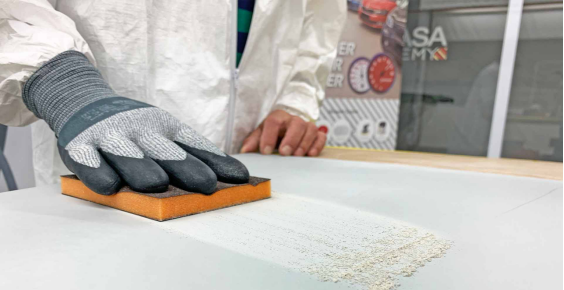Sanding is an integral part of various DIY projects, woodworking, and other crafts. To achieve a smooth and polished finish, using the right sanding tool is crucial. Among the many sanding tools available, the sponge sanding block stands out as a versatile and efficient option. In this article, we will explore the characteristics and functions of sponge sanding blocks, highlighting their advantages and the tasks they excel at.
What is a Sponge Sanding Block?
A sponge sanding block is a handheld sanding tool made of a flexible and resilient material, typically foam or sponge. It is designed to provide a comfortable grip and allow for precise control during sanding. The sponge is coated with an abrasive material, such as aluminum oxide or silicon carbide, which aids in removing imperfections and smoothing surfaces.
Characteristics of Sponge Sanding Blocks:
Sponge sanding blocks possess several key characteristics that set them apart from other sanding tools.
- Flexibility:Sponge sanding blocks offer a unique advantage with their flexibility. Unlike rigid sanding tools, the sponge conforms to the contours of the surface being sanded, ensuring even pressure distribution. This characteristic makes sponge sanding blocks ideal for sanding curved or irregular surfaces. Whether you’re working on furniture, trim, or decorative objects, the flexibility of the sponge allows you to maintain contact with the surface, resulting in a more uniform sanding finish.
- Ergonomic Design:The ergonomic design of sponge sanding blocks enhances user comfort and control. They are lightweight and feature a contoured shape that fits comfortably in the hand, reducing fatigue during prolonged sanding sessions. The soft and cushioned surface of the sponge also minimizes strain on the fingers. With the comfortable grip provided by sponge sanding blocks, you can maintain better control over the sanding process, leading to more accurate results.
- Abrasive Grit Options:Sponge sanding blocks are available in a wide range of grits, allowing users to select the appropriate level of coarseness for their specific needs. From coarse grits for initial material removal to fine grits for polishing, there is a sponge sanding block suitable for every stage of the sanding process. The availability of different grit options makes sponge sanding blocks versatile tools that can be used for various sanding tasks, from aggressive material removal to delicate surface preparation.
Functions of Sponge Sanding Blocks:
Equipped with the aforementioned characteristics, sponge sanding blocks excel in numerous applications.
- Surface Preparation:Prior to painting, staining, or varnishing, it is essential to prepare the surface by removing old paint, rough spots, and imperfections. Sponge sanding blocks are highly effective in this regard. Their flexibility enables them to reach tight corners and contoured surfaces, ensuring a thorough and even removal of unwanted materials. Whether you’re refinishing a piece of furniture or preparing a wall for painting, sponge sanding blocks are excellent tools for achieving a smooth and clean surface.
- Smoothing and Leveling: Whether working on wood, metal, or other materials, achieving a smooth and level surface is crucial. Sponge sanding blocks excel at this task due to their ability to conform to uneven surfaces. They can quickly remove rough patches, bumps, and irregularities, resulting in a uniform and professional finish. When you’re working with materials that have slight imperfections or undulations, a sponge sanding block can help you smooth out the surface and create a more appealing final product.
- Finishing Touches: After the bulk of the sanding is complete, a sponge sanding block becomes invaluable for achieving a polished and refined surface. The fine-grit sponges are perfect for removing fine scratches, preparing surfaces for painting, or providing a smooth base for applying finishes like varnish or wax. With their gentle yet effective abrasive action, sponge sanding blocks help you achieve a professional finish by eliminating minor blemishes and preparing the surface for the final touches.
- Wet or Dry Sanding: One of the remarkable features of sponge sanding blocks is their versatility in wet and dry sanding When used with water, they minimize dust and clogging, providing a cleaner working environment. Wet sanding is particularly useful for finishing tasks and achieving a high-gloss finish on surfaces like automotive paint. The ability to use sponge sanding blocks with water expands their capabilities and allows for more controlled and efficient sanding.
Conclusion:
Sponge sanding blocks offer a range of advantages, making them an indispensable tool for various sanding applications. Their flexibility, ergonomic design, and abrasive grit options make them ideal for surface preparation, smoothing, and finishing touches. Whether you are a DIY enthusiast or a professional craftsman, having a sponge sanding block in your toolbox will undoubtedly enhance your sanding experience and deliver excellent results. From rough material removal to delicate surface preparation, the sponge sanding block is a versatile and efficient tool that deserves a place in every woodworker’s arsenal.


